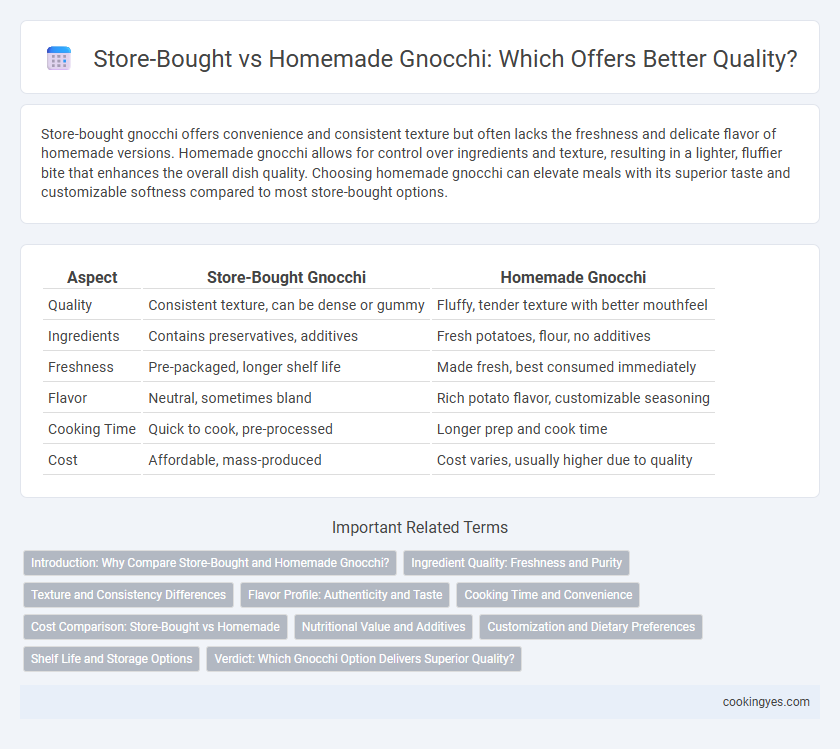Store-bought gnocchi offers convenience and consistent texture but often lacks the freshness and delicate flavor of homemade versions. Homemade gnocchi allows for control over ingredients and texture, resulting in a lighter, fluffier bite that enhances the overall dish quality. Choosing homemade gnocchi can elevate meals with its superior taste and customizable softness compared to most store-bought options.
Table of Comparison
| Aspect | Store-Bought Gnocchi | Homemade Gnocchi |
|---|---|---|
| Quality | Consistent texture, can be dense or gummy | Fluffy, tender texture with better mouthfeel |
| Ingredients | Contains preservatives, additives | Fresh potatoes, flour, no additives |
| Freshness | Pre-packaged, longer shelf life | Made fresh, best consumed immediately |
| Flavor | Neutral, sometimes bland | Rich potato flavor, customizable seasoning |
| Cooking Time | Quick to cook, pre-processed | Longer prep and cook time |
| Cost | Affordable, mass-produced | Cost varies, usually higher due to quality |
Introduction: Why Compare Store-Bought and Homemade Gnocchi?
Store-bought gnocchi offers convenience with consistent texture and flavor, while homemade gnocchi allows control over ingredients and freshness, resulting in a more tender and flavorful dish. Quality in gnocchi hinges on factors like potato type, flour content, and dough handling, which are often superior in homemade versions. Comparing these two highlights the trade-offs between convenience and culinary craftsmanship essential for authentic Italian cuisine.
Ingredient Quality: Freshness and Purity
Homemade gnocchi typically offers superior ingredient quality, using fresh potatoes, flour, and eggs, ensuring purity and freshness that store-bought versions often lack. Store-bought gnocchi may contain preservatives and lower-quality potatoes, impacting the texture and flavor. Freshness in homemade gnocchi results in a softer, more delicate bite and a richer taste profile.
Texture and Consistency Differences
Store-bought gnocchi often has a denser texture and uniform consistency due to mass production techniques, which can result in a less delicate bite compared to homemade versions. Homemade gnocchi typically feature a lighter, fluffier texture with slight variations in size and shape that enhance mouthfeel and absorb sauces more effectively. The use of fresh ingredients and manual shaping in homemade gnocchi contributes to a superior overall texture and culinary experience.
Flavor Profile: Authenticity and Taste
Homemade gnocchi offers a superior flavor profile with a distinct, authentic taste derived from fresh ingredients like real potatoes, eggs, and flour, delivering a tender and pillowy texture unmatched by store-bought versions. Store-bought gnocchi often contain preservatives and fillers that dilute the natural flavors and result in a denser, less delicate bite. For an authentic Italian culinary experience, homemade gnocchi preserves the traditional richness and subtle nuances of flavor that are often lost in mass-produced alternatives.
Cooking Time and Convenience
Store-bought gnocchi offers convenience with minimal cooking time, usually ready in 2-3 minutes once they float to the surface, making it ideal for quick meals. Homemade gnocchi requires more preparation and a longer cooking process, typically boiling for 1-2 minutes, but provides superior texture and freshness that enhances flavor. While store-bought options sacrifice some quality for speed, homemade gnocchi ensures a delicate, pillowy consistency preferred by culinary enthusiasts.
Cost Comparison: Store-Bought vs Homemade
Store-bought gnocchi typically costs between $3 and $5 per pound, offering convenience but often sacrificing freshness and texture. Homemade gnocchi requires ingredients like potatoes, flour, and eggs costing approximately $2 to $3 per pound, delivering superior quality and customizable flavor. Factoring in time and preparation skills, homemade gnocchi provides better value for quality-conscious cooks despite higher labor input.
Nutritional Value and Additives
Store-bought gnocchi often contains preservatives and additives like sodium acid pyrophosphate for texture retention, which may reduce its nutritional value compared to homemade gnocchi. Homemade gnocchi typically uses fresh ingredients such as potatoes, flour, and eggs, ensuring higher nutrient density and absence of artificial additives. The fresher preparation method results in lower sodium content and better control over ingredient quality, enhancing overall nutritional benefits.
Customization and Dietary Preferences
Homemade gnocchi offers superior customization, allowing control over ingredients to accommodate dietary preferences like gluten-free or vegan options, enhancing both taste and nutrition. Store-bought gnocchi provides convenience but often contains preservatives and less flexibility in texture and flavor compared to fresh, handmade varieties. Opting for homemade gnocchi ensures a tailored, high-quality experience that meets specific dietary needs.
Shelf Life and Storage Options
Store-bought gnocchi offers convenience with a longer shelf life, typically lasting up to several weeks when refrigerated and several months if frozen, due to preservatives and vacuum-sealed packaging. Homemade gnocchi boasts superior freshness and texture but has a limited shelf life of about 1-2 days in the refrigerator and requires freezing for extended storage, which may slightly alter its delicate consistency. Choosing between the two depends on balancing immediate quality against storage flexibility and convenience.
Verdict: Which Gnocchi Option Delivers Superior Quality?
Homemade gnocchi typically offers superior quality due to the use of fresh ingredients and the ability to control texture and flavor, resulting in a delicate, pillowy consistency unmatched by store-bought versions. Store-bought gnocchi, while convenient, often contains preservatives and lacks the tender, light texture of freshly made dough. The verdict favors homemade gnocchi for those prioritizing authenticity, freshness, and superior taste.
Store-bought gnocchi vs homemade gnocchi for quality Infographic

 cookingyes.com
cookingyes.com